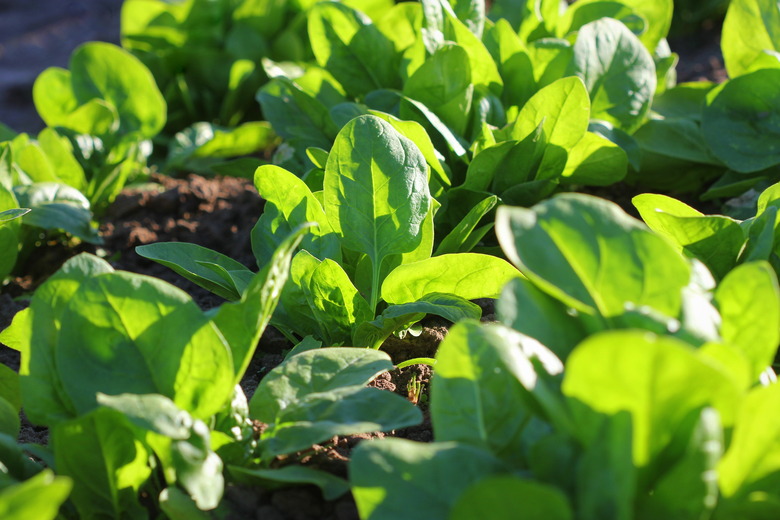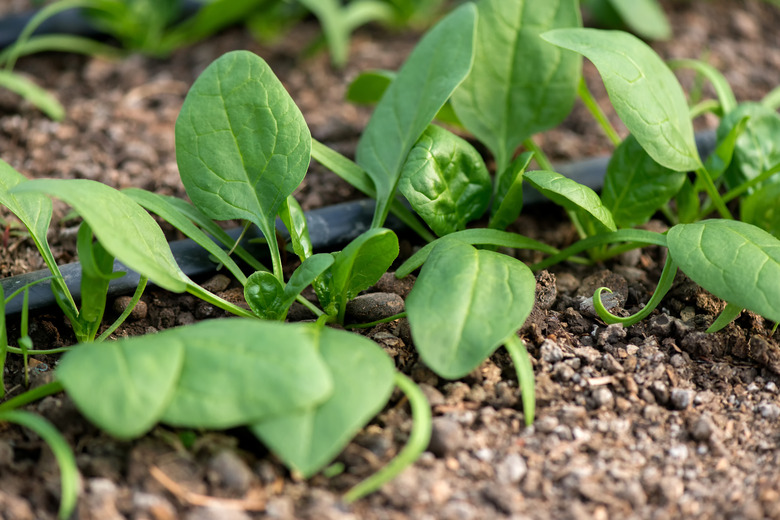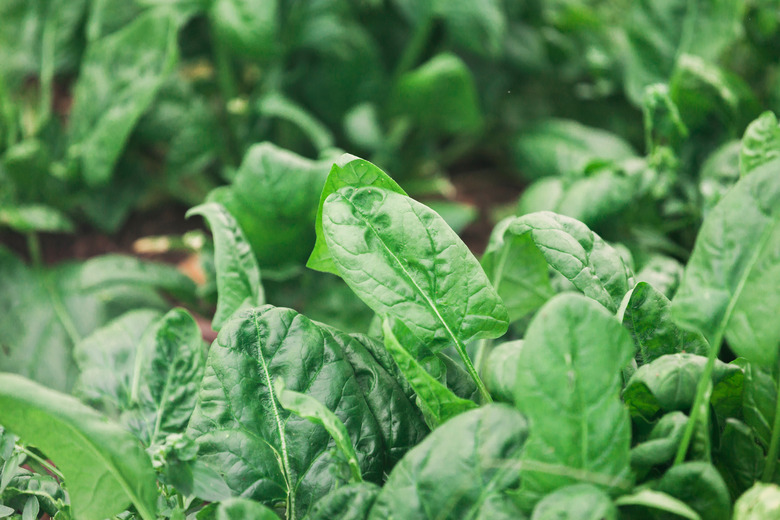How To Grow Spinach
We may receive a commission on purchases made from links.
The dark-green leaves of spinach (Spinacia oleracea) are not only an attractive addition to your garden, but they are also delicious and nutritious, filled with vitamins A, B2, B6, C, E, and K as well as manganese, folate, copper, and calcium. While spinach may be a common sight all year long in the grocery store, when you grow these leafy greens at home, you'll quickly find that it is strictly a cool-season crop that does not do well in hot weather. In fact, warm weather causes it to send up a flower-covered seed stalk in a process known as bolting, which will make the entire plant taste bitter.
With that in mind, most growers will want to limit their planting and harvesting efforts to spring and early fall, though some people will have success planting spinach in late fall or even throughout winter if they live somewhere that doesn't suffer from excessive frost.
Best Uses for Spinach
Best Uses for Spinach
Spinach, like other leafy greens such as kale, lettuce, and chard, is fairly easy to grow and sprouts quickly, making it a great crop for novice gardeners. The delicate, dark-green leaves look attractive in window boxes and other planters, but if you want a decent amount to harvest, you'll want to grow it in a full-sized garden so you don't wipe out all your plants trying to collect enough leaves for your next salad. This plant does not take well to transplanting, so it should be started in the same bed or planter where it will be grown for the duration of its life cycle (which, as an annual, will be for one growing season).
Spinach grows well next to eggplants, leeks, lettuce, radishes, peas, and strawberries, but it does not do well with plants that have particularly long roots that stay close to the surface like those of potatoes, which may choke out spinach plants.
Starting Spinach From Seed
Starting Spinach From Seed
Spinach seeds are inexpensive and easy to germinate, which is why most gardeners prefer to start spinach plants by seed, especially considering that spinach seedlings often do poorly with transplanting. You can start growing as soon as you can work the soil in early spring, up to six weeks before the last frost in your area. Prior to planting, enrich the soil by working a 4-inch layer of aged animal manure and compost into the soil. To get a head start on your spring planting, you can even prepare the soil during the prior autumn.
Before sowing, soak seeds in water for a few hours to boost germination rates. Then, working in rows 14 inches apart, sow seeds at a depth of 1/2 inch, spaced 2 inches apart. Germination usually takes five to nine days, although it may take longer in particularly cool weather. Because overcrowding will slow leaf growth and accelerate the bolting process, thin seedlings to 4 to 6 inches apart once they have two or more full leaves.
When the plants grow four or more full leaves, fertilize with fish emulsion or compost tea. Make successive plantings every 10 days until mid-May so you can have fresh, healthy leaves throughout the growing season. Harvest plants immediately when you notice bolting by cutting down the plant entirely at the soil level. Then, remove and dispose of the roots.
Seeds don't like to germinate in soil that is over 70 degrees Fahrenheit, and the plants will start bolting and eventually die off if the weather is routinely over 75 degrees, and there are more than 13 hours of sunlight. This means that in most growing areas, you'll have to stop planting by mid-May and wait until fall to start planting again. In fall, you can once again sow spinach seeds after soil temperatures drop provided that your plants will have at least four weeks before the first frost date.
In What Zone Does Spinach Grow Best?
In What Zone Does Spinach Grow Best?
The great thing about spinach being a cold-weather crop is that it can be grown in a wide variety of areas throughout USDA zones 2 through 11. In fact, spinach can survive in temperatures all the way down to the mid-teens and will germinate in temperatures up to 70 degrees.
When growing in warm weather, the germination rate will drop significantly (as much as 50 percent when the soil rises above 70 degrees), so don't be afraid of doing a very heavy seeding to compensate. Also, be sure to mulch well to keep your garden soil moist and water frequently, as often as twice a day, to help keep the ground cool. You can use shade cloth to provide partial shade on days when temperatures exceed 80 degrees, or you may want to grow the spinach beside a shade-providing plant, such as pole beans or corn. Alternatively, you can also choose to grow Malabar spinach (Basella alba, USDA zones 9-11), which isn't related to true spinach, with edible leaves that can be eaten raw or cooked like true spinach. Malabar flourishes in hot weather, making it a good substitute for true spinach in warm climates.
For those growing spinach in cool Northern areas, you may be able to sow seeds just before cold winter weather arrives in fall. This will allow you to prepare for an early spring harvest as long as you protect the plants from frost with a cold frame, row covers, or a thick layer of mulch. Remove these protective cold barriers when the soil temperature reaches an average of 40 degrees.
When Should You Plant Spinach?
When Should You Plant Spinach?
Because spinach can thrive in such a wide array of conditions, the most important factor on which to focus is finding the best time of year to plant in your area. The majority of climates in America are well-suited to spring and fall growing seasons, but in particularly warm areas, winter might actually be the ideal time to plant spinach.
One general rule regardless of your growing region is that all but the most experienced gardener should avoid growing spinach in late summer. This is because it is difficult to get the seeds to germinate and because the long summer days will quickly result in bolting, causing the spinach leaves to develop an unpleasant bitter flavor and tough texture.
Soil, Sunlight and Water Recommendations for Spinach
Soil, Sunlight and Water Recommendations for Spinach
Spinach is one of a limited number of vegetables that prefers alkaline soil over acidic soil, though it does just fine with a neutral pH. It also prefers loamy soil that holds in moisture and does not grow well in sandy soil or heavy clay. If your soil is poorly adapted to spinach, you might find it easier to plant this leafy vegetable in raised beds rather than reworking the ground.
Spinach prefers full sun in most areas and most times of the year, but the sun can cause the plant to start to bolt in midsummer. As a result, shade cloth can be installed when temperatures exceed 80 degrees or when there will be more than 13 hours of sunlight a day. If you're concerned about bolting, you may also try a cultivar such as 'Bloomsdale Long Standing,' 'Big Crop' or 'America,' which resist flower bolting and thus have a longer growing season.
Ensure the plant gets ample moisture but that the soil does not get too soggy. Raised beds allow for better drainage, and mulch can help maintain moisture in the soil and suppress weeds, which is particularly helpful since manually pulling out weeds can easily result in accidentally damaging the delicate spinach roots.
How to Harvest Spinach
How to Harvest Spinach
You can start your initial spring harvest as soon as six to eight weeks after planting. You'll know you can harvest your spinach when the plant has at least six 3-inch-long leaves. Carefully trimming the outer leaves after they are at least 3 inches tall will help keep the plant alive and producing well. Don't wait too long to harvest, as overgrown leaves will be bitter, and this can also speed up the bolting process.
When you first notice that the plant is bolting, harvest the entire plant by cutting it just below the surface of the soil. This will ensure you can enjoy all the remaining leaves before they begin to turn bitter.
Common Pests and Other Problems for Spinach
Common Pests and Other Problems for Spinach
There are many pests that cause damage to spinach leaves, including leaf miners, aphids, caterpillars, flea beetles, slugs, snails and spider mites. Leaf miners produce telltale tan patches on the leaves and white tunnels in the leaves when their larvae burrow inside. These can be prevented by adding a row cover. For plants that are already infested, you may choose to remove and destroy all of the damaged leaves to prevent adult flies from spreading.
Aphids can be sprayed off leaves with a garden hose. For caterpillars, pick off the insects by hand or try a biological worm spray to avoid using toxic pesticides. Insecticidal soap, diatomaceous earth or neem oil can help eliminate almost all spinach pests.
If you're having difficulty getting seeds to germinate, you may be sowing the seeds too shallow, planting in overly warm soil or using old seeds because spinach seeds don't last very long. Check that your soil is below 70 degrees, purchase a new package of seeds and sow again at a depth of just over 1/2 inch.
When leaves are yellow, your plants may not be getting enough nitrogen, which a soil test can determine. In the absence of a soil test, start side-dressing your garden with a 10-10-10 fertilizer or organic equivalent every two weeks, keeping the fertilizer 4 inches away from the delicate leaves to avoid burning them.
Common Diseases for Spinach
Common Diseases for Spinach
The main diseases that affect spinach crops are spinach blight, downy mildew, white rust, and fusarium wilt. Spinach blight, also called cucumber mosaic virus, causes yellow leaves and will stunt growth. It can be spread by pests such as aphids or leaf miners. To treat blight, be sure to remove and destroy all infected plants and step up your pest control techniques. Alternatively, consider planting the 'Winter Bloomsdale' spinach cultivar, which is resistant to this virus.
Downy mildew, also called blue mold, shows up as yellow spots on the top of the leaf with mold on the underside. White rust looks similar to start with, only entire leaves will eventually start turning yellow and will develop blisters. Both diseases appear in wet, cold, and humid conditions and can be treated by removing the affected leaves if the infection is not severe or using a fungicide designed for such purposes if the issue is widespread. Avoid working with wet plants when possible to avoid spreading these diseases. The 'Tyee' cultivar of spinach is resistant to downy mildew and is tolerant of white rust, so if you live in a very damp area, you may consider this cultivar.
Fusarium is a fungal disease that causes the plant to turn yellow on one side and suffer from stunted growth. If you notice this problem, remove and destroy all infected plants and grow other vegetables in the area for a period of at least three years before planting spinach there again.


